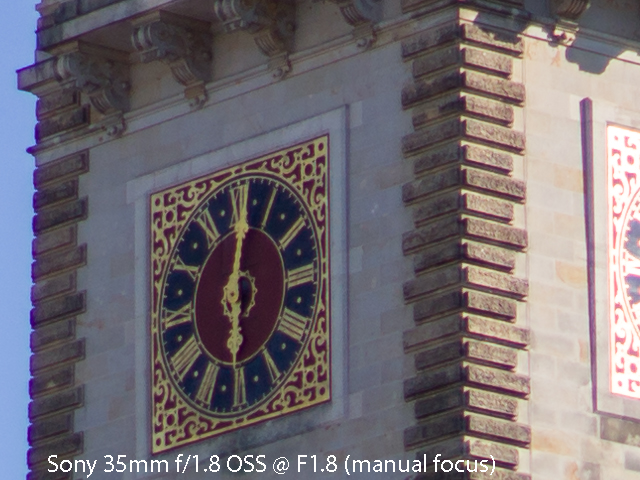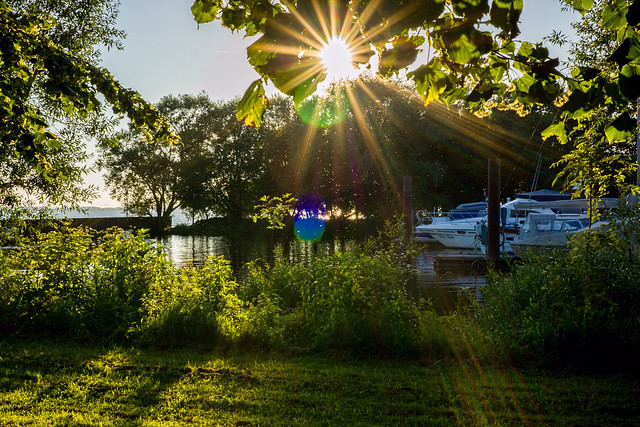August 2013 - time for some summerly (re-)views. Before this autumn will propably distract us to new fullframe NEX camera bodies and lenses, let us compare some of the latest offerings in the range of bright ~35mm lenses with a field of view equivalent to a 50mm lens on fullframe sensors. Beside some others, you can currently choose between the new Zeiss Touit Planar T* 32mm f/1.8, the Sony 35mm f/1.8 OSS and the SLR Magic HyperPrime CINE 35mm T0.95 (available from September 2013). This article will provide you an in-depth comparison between these lenses.
Before we go into details, let's compare sizes of the main competitors:

Left: Sony 35mm f/1.8 OSS, right: Zeiss Touit Planar T* 1.8/32 and their lens hoods
(image taken with the HyperPrime CINE 35 T0.95 (stopped down to T4.0 still showing round circles of confusion)
The Sony lens is a tad more compact than the Zeiss, the latter appears a bit more solid and with nicer haptics.
Before we come to a more detailed comparison, let me show you an example that I find quite significant for this type of lens, as it gives a good idea about the viewing angle and the depth-of-field that you can achieve at 32mm f/1.8 on an APS-C crop sensor:

Triathlon world championship 2013 in Hamburg, shot with the Zeiss Touit 1.8/32 @ F1.8
Sharpness comparison
Comparing sharpness at open aperture on a NEX-7 is fraught with risk as during my tests many of the shots were not optimally focussed when using autofocus at f/1.8. This happens with the Sony as well as with the Zeiss lens and may be a weakness of the NEX-7 (using current firmware 1.02) but at least the AF motor of the Sony lens is faster and less noisy. If you saw comparisons on other sites showing blurry 100% crops at F1.8, there is some chance that it was caused by deficient focus so it is important to compare shots that are manually focused. In order to show you the impact, here is an autofocus / manual focus comparison of some 100% crops (actual pixels):
Zeiss Touit 1.8/32 @ F1.8 on NEX-7, using autofocus, 100% crop:
Zeiss Touit 1.8/32 @ F1.8 with manual focussing, 100% crop:
Now the same view (100% crops) with the Sony:
Sony 35mm f/1.8 OSS @ F1.8 on NEX-7 using autofocus, 100% crop:
Sony 35mm f/1.8 OSS @ F1.8 with manual focus, 100% crop:
For completeness, here are the full views of the manually focussed samples:


(you can click on the images in order to open them in higher resolutions):
This is another comparison example, both manually focussed:
Zeiss Touit 1.8/32, 100% crop:
Sony SEL3518 OSS, 100% crop:
Again - for completeness - the full views:


(you can click on the images in order to open them in higher resolutions):
If you compare the 100% crops at open aperture, you will see a little advantage for the Zeiss Touit. It is a bit sharper, delivers slightly more contrast and produces less CA. It may depend on the level of perfection you demand for your purposes. Stopped down the differences become negligible in most situations but are still visible.
Bokeh comparison
More interesting for many, who choose a bright prime lens, may be the way how it renders backgrond blur (bokeh) when playing with depth of field. Let's start comparing at open aperture:
Zeiss Touit 1.8/32 @ F1.8:
Sony 35mm f/1.8 OSS @ F1.8:
SLR Magic HyperPrime CINE 35mm T0.95 @ T0.95:
When you click on the images to see larger sizes, these examples show a smoother bokeh for the Sony 1.8/35 OSS compared to the Zeiss Touit 1.8/32 but the only lens that is able to clearly separate the chief motive from the background creating some kind of "3D pop" is the HyperPrime CINE 35mm T0.95 which compares to a 50mm f/1.4 lens on a full frame sensor in terms of field-of-view and depth-of-field.
If you take portraits with these lenses from a closer distance, you may prefer to stop down a little bit in order to widen the depth-of-field for the area of the person. In the next example I decided to stop down to F2.8:
Zeiss Tout 1.8/32 @ F2.8:
Sony 35mm f/1.8 OSS @ F2.8:
If you click on the images to see them at larger size, you may determine that at F2.8 the Zeiss renders the smoother bokeh. At the end of this article you will find some more examples (also from the HyperPrime CiNE 35/T0.95).
Back light
When shooting against the light, you may get flares with all of these lenses. Unfortunately I did not have all of them with me, when I could catch this "positive" use case:
The Verdict
- When sharpness and contrast has highest priority, the Zeiss Touit 1.8/32 may be the best choice for you. It keeps the nose also ahead when stopped down.
- The AF of the Zeiss is significantly slower and noisier than the AF of the Sony. Inaccuracy may be a problem in some situations as well but seem to be caused by the NEX-7 itself.
- The Sony 35mm f/1.8 OSS convinces me more in terms of bokeh quality and provides you some more low light reserves due to its optical stabilization. From my point of view it offers the best value for money.
- If you strive for the most shallow depth of field and creamiest bokeh comparable to a 50/1.4 lens on a fullframe sensor and can live with a bulky manual lens, the SLR Magic HyperPrime CINE 35mm T0.95 may be the best choice for you. It was tested earlier here and here as well.
Let me close this article with another set of shots from these lenses taken at open aperture:
Zeiss Touit 1.8/32 @ F1.8:
Sony 35mm f/1.8 OSS @ F1.8:
SLR Magic HyperPrime CINE 35mm T0.95 @ T0.95:
Model: Ionica Patruta













